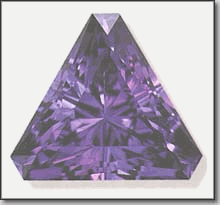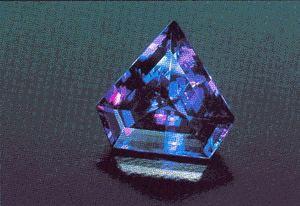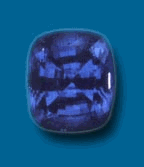

Cleavage and Fracture is the way the mineral breaks. Cleavage is when a mineral breaks along a flat surface. An example of cleavage would be shale. You can break shale into thin, flat pieces. Fracture is when a mineral breaks along uneven surfaces. An example of fracture is Galena. Galena does not break along even surfaces. You could not break it into flat pieces. It breaks in chunks. Sometimes it will look like Jell-O when a mineral breaks apart and it has fracture.
Tanzanite has perfect cleavage in one direction. This means that it will break into perfectly flat pieces, only if broken in a certain direction.
Hardness
 A mineral’s hardness is measured by Moh’s Hardness Scale. This measures the hardness of one mineral compared to another. A man named Friedrich Moh invented the scale. The scale ranges from 1-10. 1 is talc, 2 is gypsum, 3 is calcite, 4 is fluorite, 5 is apatite, 6 is orthoclase, 7 is quartz, 8 is topaz, 9 is corundum, and 10 is diamond. To find out what a minerals hardness is you rub one of the 10 minerals against the mineral you’re testing. If one of the 10 scratches it, that means that it is less dense then the other mineral. They then go down the list of the 10 minerals scratching each one against the mineral your testing until they find one that does not scratch it. This means that the mineral being tested is more dense then the other mineral. This is how they rate minerals using Moh’s hardness scale. Tanzanite is rated a 6.5 on the Moh’s hardness scale. This means that it is more dense then orthoclase, but less dense then quartz.
A mineral’s hardness is measured by Moh’s Hardness Scale. This measures the hardness of one mineral compared to another. A man named Friedrich Moh invented the scale. The scale ranges from 1-10. 1 is talc, 2 is gypsum, 3 is calcite, 4 is fluorite, 5 is apatite, 6 is orthoclase, 7 is quartz, 8 is topaz, 9 is corundum, and 10 is diamond. To find out what a minerals hardness is you rub one of the 10 minerals against the mineral you’re testing. If one of the 10 scratches it, that means that it is less dense then the other mineral. They then go down the list of the 10 minerals scratching each one against the mineral your testing until they find one that does not scratch it. This means that the mineral being tested is more dense then the other mineral. This is how they rate minerals using Moh’s hardness scale. Tanzanite is rated a 6.5 on the Moh’s hardness scale. This means that it is more dense then orthoclase, but less dense then quartz.
Streak
Although a mineral is one color on the outside its powder may be a different color. To find out what the color of a minerals powder is you must rub the mineral against a piece of unglazed porcelain. This is a minerals streak. This is a better way of identifying a mineral then by just looking at its color. Tanzanite is a bluish-purple color on the outside but its streak is white. This shows that although a mineral is one color its powder can be completely different.
Luster
 Luster is the description of the way light enteracts with the surface of a mineral. Adamantine, dull, earthy, fiberous, greasy, gumdrop, metallic, pearly, pitchy, resinous, silky, submetallic, vitreous, and waxy are all words that describe a minerals luster. Tanzanite has a vitreous luster, which means that is has a glassy look. Tanzanite is also transparent, and translucent.
Luster is the description of the way light enteracts with the surface of a mineral. Adamantine, dull, earthy, fiberous, greasy, gumdrop, metallic, pearly, pitchy, resinous, silky, submetallic, vitreous, and waxy are all words that describe a minerals luster. Tanzanite has a vitreous luster, which means that is has a glassy look. Tanzanite is also transparent, and translucent.
Miscelaneous Information
 All minerals have special properties. Special properties are individual features that minerals have. One of Tanzania’s special properties is that it has something called pleochroism. This means that if you look at Tanzanite from different angles you can see different colors. From one angle it appears blue-purple. If you look at it from another angle it appears to be green-yellow, and if you look at it from another angle it seems to be red-purple. As you can see in this picture to the left you can see purple, blue, and green. This property makes it easy to identify Tanzanite because it is a rare property. Another
All minerals have special properties. Special properties are individual features that minerals have. One of Tanzania’s special properties is that it has something called pleochroism. This means that if you look at Tanzanite from different angles you can see different colors. From one angle it appears blue-purple. If you look at it from another angle it appears to be green-yellow, and if you look at it from another angle it seems to be red-purple. As you can see in this picture to the left you can see purple, blue, and green. This property makes it easy to identify Tanzanite because it is a rare property. Another  special property is that different lighting can bring out different colors in Tanzanite. Sunlight brings out the purple in it. Light bulbs and candles can also bring out the purple in Tanzanite. Fluorescent lights and overcast skies tend to bring out the blue in Tanzanite more so then sunlight and light bulbs.
special property is that different lighting can bring out different colors in Tanzanite. Sunlight brings out the purple in it. Light bulbs and candles can also bring out the purple in Tanzanite. Fluorescent lights and overcast skies tend to bring out the blue in Tanzanite more so then sunlight and light bulbs.
Tanzanite is in the orthorhombic crystal system. Tanzanite is a hydrated calcium aluminum silicate mineral with a chemical formula of Ca2Al3Si3O12(OH). It is 18.76% calcium, 12.63% aluminum, 19.71% silicon, .24% hydrogen, and 48.67% oxygen.
Density
Density is the amount of matter in a given amount of space. It the ratio of an objects mass to its volume. Density is measured in grams per cubic centimeter. Water is used as a reference point for other substances because it has a density of 1 g/cm3. The ratio of an objects density to the density of water is the objects specific gravity. Tanzanite has a specific gravity of 3.75. This means that Tanzanite’s density is 3.75 g/cm3 . This means that there is 3.75 times more matter in 1 cm3 of Tanzanite than in 1 cm3 of water.